Yongbo He
VisMem: Latent Vision Memory Unlocks Potential of Vision-Language Models
Nov 14, 2025Abstract:Despite the remarkable success of Vision-Language Models (VLMs), their performance on a range of complex visual tasks is often hindered by a "visual processing bottleneck": a propensity to lose grounding in visual evidence and exhibit a deficit in contextualized visual experience during prolonged generation. Drawing inspiration from human cognitive memory theory, which distinguishes short-term visually-dominant memory and long-term semantically-dominant memory, we propose VisMem, a cognitively-aligned framework that equips VLMs with dynamic latent vision memories, a short-term module for fine-grained perceptual retention and a long-term module for abstract semantic consolidation. These memories are seamlessly invoked during inference, allowing VLMs to maintain both perceptual fidelity and semantic consistency across thinking and generation. Extensive experiments across diverse visual benchmarks for understanding, reasoning, and generation reveal that VisMem delivers a significant average performance boost of 11.8% relative to the vanilla model and outperforms all counterparts, establishing a new paradigm for latent-space memory enhancement. The code will be available: https://github.com/YU-deep/VisMem.git.
SRGS: Super-Resolution 3D Gaussian Splatting
Apr 16, 2024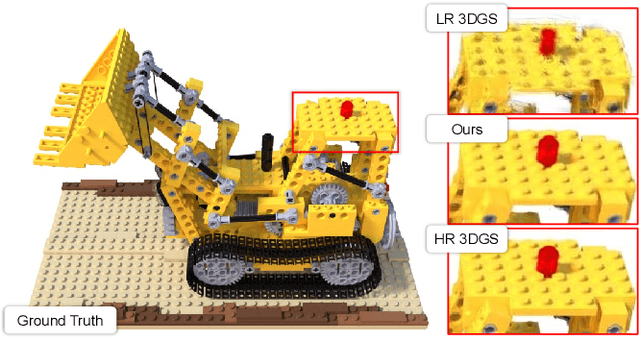

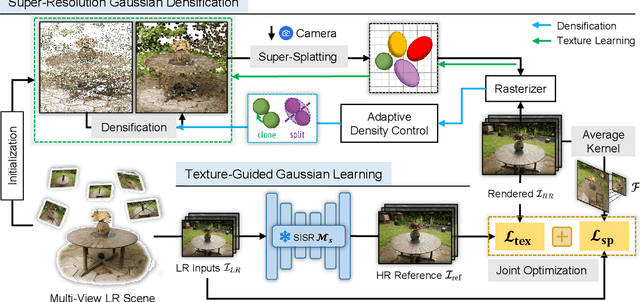

Abstract:Recently, 3D Gaussian Splatting (3DGS) has gained popularity as a novel explicit 3D representation. This approach relies on the representation power of Gaussian primitives to provide a high-quality rendering. However, primitives optimized at low resolution inevitably exhibit sparsity and texture deficiency, posing a challenge for achieving high-resolution novel view synthesis (HRNVS). To address this problem, we propose Super-Resolution 3D Gaussian Splatting (SRGS) to perform the optimization in a high-resolution (HR) space. The sub-pixel constraint is introduced for the increased viewpoints in HR space, exploiting the sub-pixel cross-view information of the multiple low-resolution (LR) views. The gradient accumulated from more viewpoints will facilitate the densification of primitives. Furthermore, a pre-trained 2D super-resolution model is integrated with the sub-pixel constraint, enabling these dense primitives to learn faithful texture features. In general, our method focuses on densification and texture learning to effectively enhance the representation ability of primitives. Experimentally, our method achieves high rendering quality on HRNVS only with LR inputs, outperforming state-of-the-art methods on challenging datasets such as Mip-NeRF 360 and Tanks & Temples. Related codes will be released upon acceptance.
ZS-SRT: An Efficient Zero-Shot Super-Resolution Training Method for Neural Radiance Fields
Dec 19, 2023
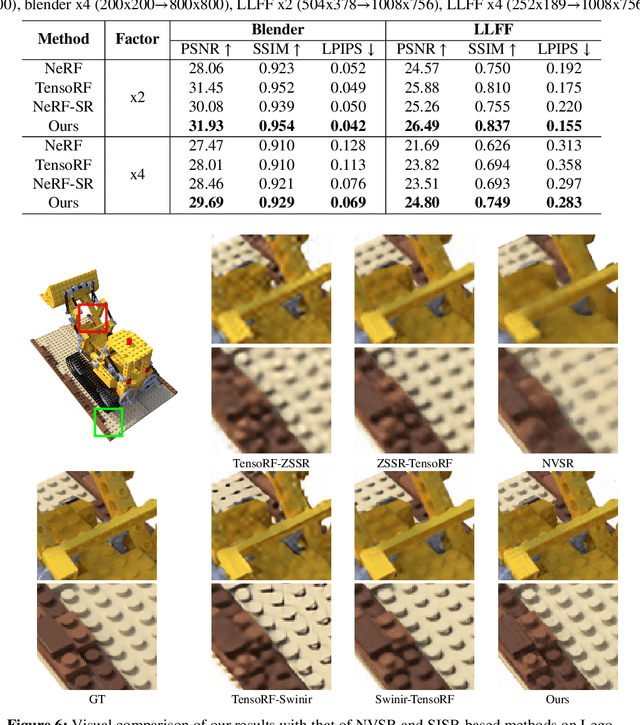
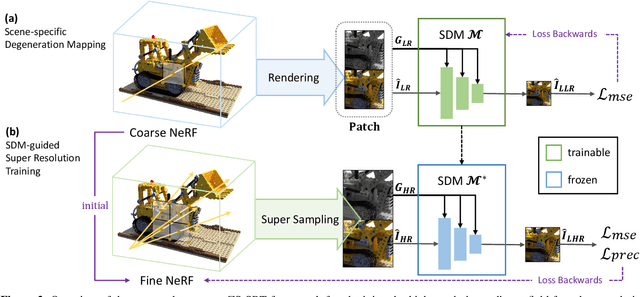
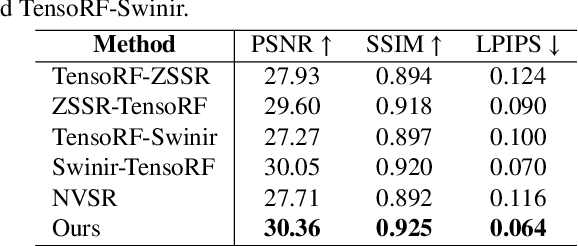
Abstract:Neural Radiance Fields (NeRF) have achieved great success in the task of synthesizing novel views that preserve the same resolution as the training views. However, it is challenging for NeRF to synthesize high-quality high-resolution novel views with low-resolution training data. To solve this problem, we propose a zero-shot super-resolution training framework for NeRF. This framework aims to guide the NeRF model to synthesize high-resolution novel views via single-scene internal learning rather than requiring any external high-resolution training data. Our approach consists of two stages. First, we learn a scene-specific degradation mapping by performing internal learning on a pretrained low-resolution coarse NeRF. Second, we optimize a super-resolution fine NeRF by conducting inverse rendering with our mapping function so as to backpropagate the gradients from low-resolution 2D space into the super-resolution 3D sampling space. Then, we further introduce a temporal ensemble strategy in the inference phase to compensate for the scene estimation errors. Our method is featured on two points: (1) it does not consume high-resolution views or additional scene data to train super-resolution NeRF; (2) it can speed up the training process by adopting a coarse-to-fine strategy. By conducting extensive experiments on public datasets, we have qualitatively and quantitatively demonstrated the effectiveness of our method.
FDNet: Feature Decoupled Segmentation Network for Tooth CBCT Image
Nov 11, 2023Abstract:Precise Tooth Cone Beam Computed Tomography (CBCT) image segmentation is crucial for orthodontic treatment planning. In this paper, we propose FDNet, a Feature Decoupled Segmentation Network, to excel in the face of the variable dental conditions encountered in CBCT scans, such as complex artifacts and indistinct tooth boundaries. The Low-Frequency Wavelet Transform (LF-Wavelet) is employed to enrich the semantic content by emphasizing the global structural integrity of the teeth, while the SAM encoder is leveraged to refine the boundary delineation, thus improving the contrast between adjacent dental structures. By integrating these dual aspects, FDNet adeptly addresses the semantic gap, providing a detailed and accurate segmentation. The framework's effectiveness is validated through rigorous benchmarks, achieving the top Dice and IoU scores of 85.28% and 75.23%, respectively. This innovative decoupling of semantic and boundary features capitalizes on the unique strengths of each element to significantly elevate the quality of segmentation performance.
 Add to Chrome
Add to Chrome Add to Firefox
Add to Firefox Add to Edge
Add to Edge